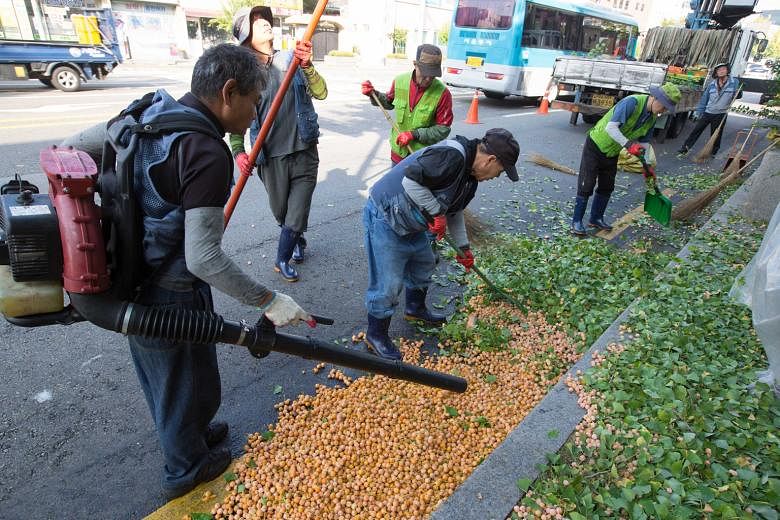Coffee is brewing at a cafe in Jahamun Road in central Seoul one breezy autumn morning, but the aroma is overshadowed by something else reeking from the pavement outside.
It is the pungent odour of ginkgo fruit that has fallen from the trees, lining the street and ended up being trampled on by passers-by, leaving behind a messy, stinking trail.
Some say it smells like rotten cheese, some say it smells like vomit, and others say it smells like poop.
The stench is a recurring issue that has prompted affected residents to file complaints with the government. Female ginkgo trees start bearing fruit from July every year and the fruit falls naturally in September and October.
Cafe owner Lee So Oh, for one, is not very pleased to have to clean up the ginkgo mess herself.
"It bothers me that the ginkgo smell overwhelms my coffee aroma, and the pavement can get very dirty with the squashed fruit," said the 47-year-old.
So she is thankful for the government's efforts to harvest the fruit before it falls naturally, she said.
Since early this month, various district offices in Seoul have dispatched their staff to remove ginkgo fruit from populated areas before it annoys the public.
Responding to queries from The Straits Times, the Seoul Metropolitan Government (SMG) said it receives about 20 to 30 complaints from residents every year and collects about four tonnes of ginkgo fruit from the streets in its annual fight against the ginkgo stink. The collected fruit is tested for contamination and, if found to be harmless, donated to charities.
Mr Jang Hyun Soo from the central Jung-gu district office was working with a team of 11 members to remove ginkgo fruit from a tree in Jahamun Road when The Straits Times visited. Two of them, raised by a lorry crane, were seen hitting the branches with poles so the fruit would fall to the ground, where it was swept and scooped into bags by other workers. They work from 9am to 4pm and can clear about 10 to 15 trees a day, over a period of 20 days, said Mr Jang.
He said the idea to remove ginkgo fruit came from a campaign 13 years ago, when the government asked people to suggest the best way to get rid of the stench.
"It's hard work but it's our duty to remove the ginkgo fruit because the stench would lead to complaints," he said. "It smells like poop. I've gotten used to it, but other people can detect the odour very easily, so I always shower and clean myself at the office before going home in public transport."
An alternative is to relocate the female ginkgo trees to the suburbs, but the cost of 2 million won (S$2,460) to 3 million won a tree is considered high. The removal of fruit, in comparison, cost only 14 million won this year, according to the SMG.
The ginkgo tree, which is recognisable by its fan-shaped leaves, was named Seoul's official tree in the 1970s and widely planted in the streets. The trees are known to grow well and their leaves turn a much-loved beautiful yellow hue in autumn.
There are some 114,000 ginkgo trees in Seoul, making up about 40 per cent of all trees in the capital city. But only the female trees, which comprise 10 per cent of all the ginkgo trees, bear fruit. The female trees are found mostly in the populated districts of Gangnam, Songpa and Yeongdeungpo.
When crushed, the orange-coloured fruit releases butyric acid which gives off a pungent smell to prevent animals from eating it.
The nuts found inside, however, can be eaten and are popular in Korean cuisine. They can be found in porridge or chicken ginseng soup.
It is illegal for residents to pick ginkgo fruit from the trees in the streets as they are considered state property, but the SMG said it has never made an issue out of people taking the fruit home.
People stopped picking ginkgo fruit following a news report about three years ago that it could contain high levels of heavy metal from traffic pollution. But this has been found to be untrue, and the SMG said it is trying to publicise the fact that the nuts are safe for consumption.
Those who damage ginkgo trees, however, can be fined 15 million won.
- Watch the city clean-up of ginkgo fruits http://str.sg/Zurd.

